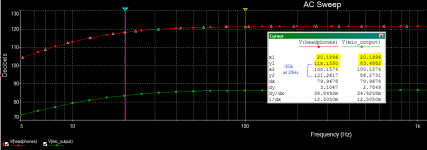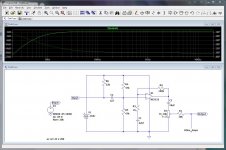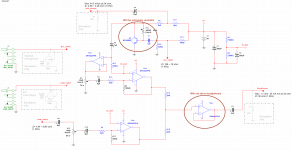Sorry, Douglas; it seems I didn't explain myself correctly. What I mean is that If I don't let the computer and start soldering/testing/readjusting, having it physically in my hands but only in a simulator, I will let it go and buy some sound box. I will go crazy with only ideas and diagrams and not having a solder in my hands. I think you can understand me now.
Regarding the computers, I was born almos 60 years ago with a solder in one hand and a nanocomputer in the other (my mother and my father worked in Philips when they met each other). But I chose the nanocomputer instead of following my father steps, and I gave away the solder.
What I mean is that I'm not abandoning the electronics and I'll continue with baby steps on it forever, but, as you can imagine, I am sick of computers and simulators and need to go to the breadboard just now. So that, I have imposed myself a time limit to start building/testing. It expires on Monday. I hope not to burn my house when I connect the circuit, but I expect to only hear cracks and hisses when I do it.
Regarding your notes about computer sound cards, you are very right but, trust me, everything has been tried out so far. The circuit is for personal use. What makes me crazy is the software thing. Too much thinking, not fighting (I think this is from Far Cry 5).
This is the result of an AC Sweep: only -3db at 20Hz. It's not too bad, is it?
Thank you again for your advices.
Regarding the computers, I was born almos 60 years ago with a solder in one hand and a nanocomputer in the other (my mother and my father worked in Philips when they met each other). But I chose the nanocomputer instead of following my father steps, and I gave away the solder.
What I mean is that I'm not abandoning the electronics and I'll continue with baby steps on it forever, but, as you can imagine, I am sick of computers and simulators and need to go to the breadboard just now. So that, I have imposed myself a time limit to start building/testing. It expires on Monday. I hope not to burn my house when I connect the circuit, but I expect to only hear cracks and hisses when I do it.
Regarding your notes about computer sound cards, you are very right but, trust me, everything has been tried out so far. The circuit is for personal use. What makes me crazy is the software thing. Too much thinking, not fighting (I think this is from Far Cry 5).
This is the result of an AC Sweep: only -3db at 20Hz. It's not too bad, is it?
Thank you again for your advices.
Attachments
What I mean is that I'm not abandoning the electronics and I'll continue with baby steps on it forever, but, as you can imagine, I am sick of computers and simulators and need to go to the breadboard just now.
Sorry to say but ... Impatience is not a good way to design a circuit.
I'm taking from this that you want a dual microphone with stereo line input mixer ... Ok, that's not terribly complex... The attached thumbnail shows a very basic microphone preamplifier.
The input is for a medium sensitivity Condenser mic. For a Dynamic Mic, remove R6. The output is line level.
Gang 4 of these up and you have a 4 channel mixer.
The gain is set by the ratio of r2 and r3, reducing r2 reduces the gain.
So for a line level input you probably want more or less unity gain so set r2 at 2.2k and remove r6.
The headphone amplifier needs a little horsepower so you may want to look into a 1 watt amplifier chip for the task. Of course your parts arrangement will depend on the chip you choose.
I hope this is helping....
Attachments
Last edited:
With the best of intentionsSorry, Douglas; it seems I didn't explain myself correctly. What I mean is that If I don't let the computer and start soldering/testing/readjusting, having it physically in my hands but only in a simulator, I will let it go and buy some sound box. I will go crazy with only ideas and diagrams and not having a solder in my hands. I think you can understand me now.
And that would be an incredibly tight timeframe.
If the end goal is the design itself, fine.
If you have to *actually* use it for something, say recording your Daughter´s piano performance or similar, then by God´s sake buy a commercial board to do that job, and later continue polishing this design, at a relaxed and realistic pace.
Just look around this very same Forum: fellow Member aided projects like this one, take Months to complete, and some last years with continuous tweaking and new Ideas.
Which is GOOD
But from now to Monday???
At least you´ll have to decide on some design , then build and testb it on, say, Protoboard, then design and make PCB, tweak it, and then maybe you´ll be close to the final product.
@JMFahey:
I found your post offensive.
@Douglas:
You seem offended or at least bothered because I want to DoItMyself and, after spending 240 hours in the simulator, I need the urgency of going into practice. I don't understand why but I didn't open this thread to discuss or to have an argument about me but to get advices about this circuit. I thank you again for your support but if something is bothering you, I think you should stop helping me.
I found your post offensive.
@Douglas:
You seem offended or at least bothered because I want to DoItMyself and, after spending 240 hours in the simulator, I need the urgency of going into practice. I don't understand why but I didn't open this thread to discuss or to have an argument about me but to get advices about this circuit. I thank you again for your support but if something is bothering you, I think you should stop helping me.
@JMFahey:
I found your post offensive.
@Douglas:
You seem offended or at least bothered because I want to DoItMyself and, after spending 240 hours in the simulator, I need the urgency of going into practice. I don't understand why but I didn't open this thread to discuss or to have an argument about me but to get advices about this circuit. I thank you again for your support but if something is bothering you, I think you should stop helping me.
Not offended, in the least. You want to explore your own design and that's just fine.
BUT I would caution you strongly about dumping on the advice of people with far more training and experience. Arrogance is a lousy teacher. We may be critical of your design and some of us (I suspect "most") would suggest alternatives as I did... and we would be doing it both to help and educate. You blow that off at your own peril.
Originally Posted by ToniGodoy
@JMFahey:
I found your post offensive.
Looks like the Forum suddenly got invaded by snowflakes who **LOVE** tio get offended by Technical answers to their problems.@ Douglas:
Now you offend me. I invite you to not write anymore in this thread.
For your information, we are NOT commenting on YOU (although you are focusing attention on your personality) but on TECHNICAL aspects, which include 2 areas:
1) the "hardware" side, the actual errors and suggestions in the design itself.
2) the "process" side, commenting on the way the project is being run, including time assigned to each stage, realistic completion prediction, and probable issues with that.
Getting angry with experienced people who are helping you on both areas won´t exactly help you.
And you already know you have important problems on both sides.
The unrealistic/impossible last Monday final date has been surpassed, which in a way is good, takes some weight from over you, now you can polish your design at a proper pace.
I´d accept advice and suggestions on design itself, resimulate the "almost final" result, polish some smaller details if needed and then, if you are happy with it, make a PCB and actually "start soldering" as you desire.
I guess you can export your simulated schematic to some PCB design package and proceed with that.
Feel free to post your preliminary PCB designs here for constructive critique and suggestions.
@ Douglas:
Now you offend me. I invite you to not write anymore in this thread.
Woah... when you opened this thread you invited comments on your design. Not one of us commented on anything personal about you. We all stuck to looking at your design and helping you improve it. It's pretty simple, up to this moment none of us knew you well enough to dislike you. Now you need to ask whether you wanted help with a project or our mass approval, because now it's likely you won't get either.
Taking personal offense in a technical discussion is absolutely not the way to go.
Using a computer's sound card to record sound is bound to result in very poor quality audio recording. The reason for this is, built in sound chips and sound cards are not designed for this purpose. Unless you have a sound card that is guaranteed by the manufacturer to provide high quality recording, you are bound to be vastly disappointed.
Several years ago, I read somewhere online, that this limitation might be possible be worked around using a mixer amplifier before feeding an audio signal to a computer. The gain of the actual computer sound chip/card should be kept very low to prevent its inherent noise from being amplified with the signal.
Alternatively:
You can try to design and build a USB sound card for recording. This will have to include an analogue to digital converter of very high quality. You can achieve this by using a fast microcontroller to sample the incoming signal and convert them to digital form. You can use an algorithm like this:
a) starting for the most significant bit, set this to 1
b) convert the number to analogue
iii) compare this with the input analogue signal
iv) if the converted signal is bigger, change the bit to 0.
v) go to the next highest bit
You will need to program the microcontroller to also communicate with the recording computer which will also need some form of driver to tell its operating system to expect digital sound input from your setup. This means, you have to write a device driver for the receiving operating system.
Several years ago, I read somewhere online, that this limitation might be possible be worked around using a mixer amplifier before feeding an audio signal to a computer. The gain of the actual computer sound chip/card should be kept very low to prevent its inherent noise from being amplified with the signal.
Alternatively:
You can try to design and build a USB sound card for recording. This will have to include an analogue to digital converter of very high quality. You can achieve this by using a fast microcontroller to sample the incoming signal and convert them to digital form. You can use an algorithm like this:
a) starting for the most significant bit, set this to 1
b) convert the number to analogue
iii) compare this with the input analogue signal
iv) if the converted signal is bigger, change the bit to 0.
v) go to the next highest bit
You will need to program the microcontroller to also communicate with the recording computer which will also need some form of driver to tell its operating system to expect digital sound input from your setup. This means, you have to write a device driver for the receiving operating system.
Last edited:
CLOSING THE THREAD
Due to two trolls who got stuck in this thread -like a bad illness- since the early stages of this topic, I'm ending it. I can't delete or close it, so I'm simply unsubscribing.
Had this forum have a button for banning such people, this wouldn't have happened. But it doesn't have this feature.
I don't know whether some people will continue writing in it or what they will write about: horses, psychology, astrology.. but I doubt that it will be about my circuit. Along 3 pages, nobody has ever answered a single question of my doubt list at the first post. I doubt that anyone has really read it. They have spoken about me, about my daughter, about what simple is to do a microphone amplifier. But I think nobody has read about the final goal -the sound localization app- the same as nobody has answered a single question of my original post.
In any case, whether they keep trolling or they continue this thread speaking about moral, paternalism, psychology, I will not be aware of it. Maybe I'll find another forum with more tech people and less trolls.
Due to two trolls who got stuck in this thread -like a bad illness- since the early stages of this topic, I'm ending it. I can't delete or close it, so I'm simply unsubscribing.
Had this forum have a button for banning such people, this wouldn't have happened. But it doesn't have this feature.
I don't know whether some people will continue writing in it or what they will write about: horses, psychology, astrology.. but I doubt that it will be about my circuit. Along 3 pages, nobody has ever answered a single question of my doubt list at the first post. I doubt that anyone has really read it. They have spoken about me, about my daughter, about what simple is to do a microphone amplifier. But I think nobody has read about the final goal -the sound localization app- the same as nobody has answered a single question of my original post.
In any case, whether they keep trolling or they continue this thread speaking about moral, paternalism, psychology, I will not be aware of it. Maybe I'll find another forum with more tech people and less trolls.
Blah bla bla ad infinitum
There are none so blind as those that won't see.
- Status
- This old topic is closed. If you want to reopen this topic, contact a moderator using the "Report Post" button.
- Home
- Amplifiers
- Chip Amps
- Sound Box design - Please, help.


